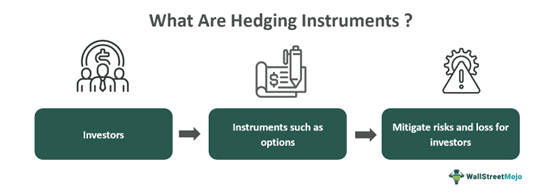Table of Contents
Hedging Instruments Meaning
A hedging instrument is a financial product that enables traders to lower or restrict the risk of an underlying asset. It may be an asset class such as commodities, shares, cash, etc. Examples of such instruments are contracts for difference, options, and futures contracts.

These instruments act as a means of protection. It acts as an option that minimizes negative effects on the portfolios of investors. It helps investors offset risk and be prepared for unfavorable price movements. Overall, they save the investors from plunging into despair by saving the portfolio if they are implemented strategically.
Key Takeaways
- A hedging instrument is a financial product that enables traders to lower or restrict the risk of an underlying asset.
- It is a financial instrument whose fair value or associated cash flows might counteract changes in the specific hedged item's fair value or cash flows.
- They can be assets, cash, forex, investments in a foreign operation, or other items with a similar designation that expose an entity to variations in fair value or cash flows.
- Hedges are categorized broadly as A fair value hedge and Cash flow hedges.
Hedging Instruments Explained
A hedging instrument is a financial instrument whose fair value or associated cash flows are expected to counteract alterations in the specific hedged item's fair value or cash flows. They can be assets, cash, forex, investments in a foreign operation, or other items with a similar designation that expose an entity to variations in fair value or cash flows.
Derivative contracts with external counterparties, except for some written options, may be categorized as hedging instruments. A written option subjects the grantor to an unlimited amount of downside risk. Except when used as an offset to a purchased option, it is typically ineffective in lowering a hedged item's profit or loss exposure. For hedge accounting purposes, instruments involving external parties to the reporting entities are designated as such. A party outside the organization preparing the accounts is called an external counterparty. These restrictions apply to intergroup transactions as well. The instruments are measured at either amortized cost or fair value and consider the money's time value.
A non-derivative financial asset or liability may only be labeled as an instrument under IAS 39 to hedge a foreign currency risk. A non-derivative instrument must be evaluated at its fair value under IFRS 9 through profit and loss to qualify as a hedging instrument for other risks. The instruments that make up an entity's equity cannot be classified as instruments that can be used for hedging. This is because they are neither the entity's financial assets nor financial liabilities.
Types
Hedges are categorized broadly as:
#1 - A Fair Value Hedge
In the fair value hedge category, the hedge experiences a change to fair value that may be attributable to certain risks and could affect the profit or loss. It may be a recognized asset, liability or firm commitment, and it even is a portion of such an asset, liability or firm commitment. Profit or loss is instantly adjusted to reflect the gain or loss resulting from the change in the instrument's fair value. The subsequent gain or loss with respect to the risked hedge is also instantly recognized in net profit or loss, and the carrying amount of the hedged item is adjusted accordingly. Simply put, Fair value hedges typically move in the opposite way of the hedged item and can be used to offset losses. Therefore, derivatives such as options and futures are examples of fair value hedges.
#2 - Cash Flow Hedge
A cash flow hedge protects against variations or sudden changes in cash flows.
- They are caused by a specific risk connected to a recognized asset or liability (such as all or a portion of interest payments (future) on variable rate debt or a possible forecast transaction and
- They may have an impact on profit or loss and include other comprehensive income accounts for the portion of the profit or loss on the instrument that is an effective hedge.
Examples
Check out these examples to get a better idea:
Example #1
Suppose Dan is an investor and he is interested in trying out hedging instruments to expand his portfolio. He learned that options and futures contracts were good choices for hedging. Dan decides to buy a stock option for 100 shares of the XYZ Company. The strike price is $50, and he pays $100 for the option. As of the expiration date, XYZ's stock prices rise to $60; Dan can still purchase them at $50 as the option's strike price and sell them at a higher price, say $60. Suppose there was no "option" exercised; he should have incurred an additional sum of $1000 ($6000-$5000) as opposed to the initial $5000, making it a loss for him (in addition to the $100 paid as premium). In detail:
He paid $5000 (50*100) and sold it for $6000 (60 *100), and the profit incurred is $1000. The premium paid has to be subtracted to get the actual profit. profit = 1000-100=900.
Example #2
Hedging is used to mitigate risks and losses. In this example, foreign exchange exposure is limited through hedging. Residents of Australia employed activities that reduced their exposure to exchange rate changes. They typically combine business activity restructuring to generate a "natural" hedge using financial derivatives to offset the foreign exchange exposures. In most cases, businesses develop strategies to manage the "net" foreign currency exposure they acquire from trade, their balance sheet, or a combination of the two. Natural hedging is expressed as structuring the primary business operations to reduce or eliminate net exposure before getting into derivative contracts. Even though this is crucial, especially for large companies with diversified operations, it is challenging to measure or notice. Sometimes, natural hedging looks impractical, expensive, or inadequate to reduce foreign exchange risks. In such cases, firms may enter explicit derivative contracts in securities to reduce risks further.
